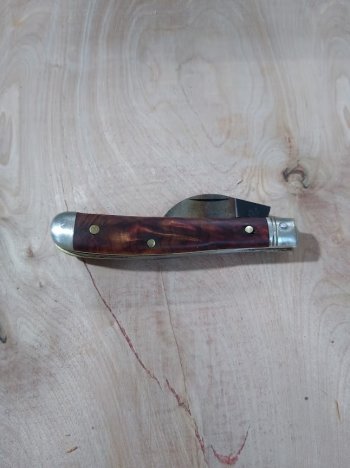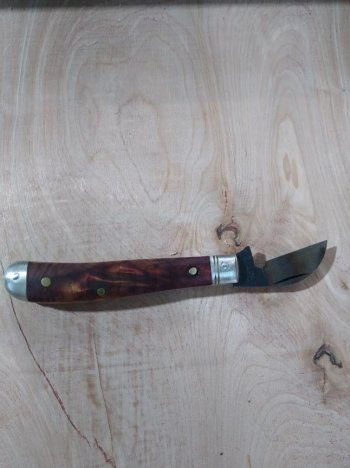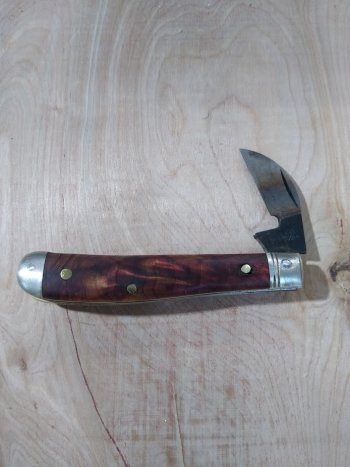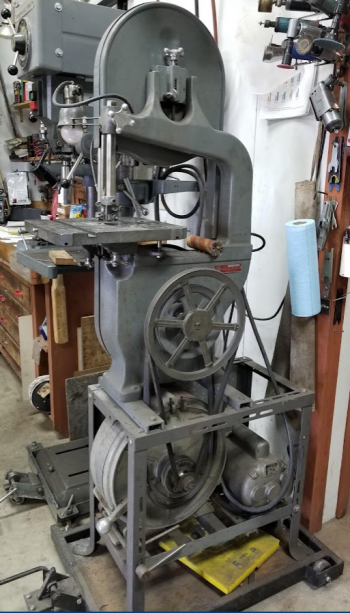I have been doing wood working for quite some time. So I have all the necessary shop tools for that. However, metal work is mostly new beyond hand work (files, hacksaws, drills, and powered sanders and grind wheels).
I tried my hand at taking apart some old knives and playing with how they work. I also bought some pre-made parts from a factory gone out of business. Moving forward, I am trying to get to the point where I can make the whole knife from the ground up. I am not, however, interested in forging. I am quite satisfied with stock removal, or even buying blades, although it seems like even when I can get blades, springs will be problematic. Lots of places sell pre-made blades, very few have springs.
I am mostly interested in slip joints and similar ilk.
I do not have a 2x72, and don't see one in the near future. I have 2 different 1x30's, and I have been able to put a nice bevel pair on a marking knife that I attempted. I also have a 4x36, that I just realized I can change the configuration on. But I have been using the one drive wheel side of that like one would the larger wheel on one of the normal grinders. Sorry, I am not sure if the proper terms yet. I also have an OSS, but I am not sure I want to use that on metal.
I have an angle grinder, and I am not afraid to use it. I have an 8" bench grinder, but since I put CBN wheels on it, I am going to simply pretend it doesn't exist, unless working on HSS. I still have a 6" bench grinder, but it is running a wire wheel, and soon to be a buffer for some finish work. I am not afraid to use a file
I also built what I guess would have been the single blade Oar Carver, (based on the parts I used). I will be redoing it since I didn't grind down the liner pins sufficiently.
I also don't have a metal cutting band saw. In theory, there is a way to slow down my 14" wood band saw, and outfit it with a bimetal blade, but I am not sure if that is in my best interest. I do own a few hack saws. I have a jig saw and scroll saw if putting metal cutting blades on them might make sense.
I have been keeping my eyes open for deals on FBM and CL but I am not sure what to look for. I have seen the band saws with the big hinge. But I am not sure how to use one of them. They look like you set them up and walk away and gravity cuts a straight line in metal. But I am not sure of that. I have also seen the ones you hold with two hands (porta-band) something of that ilk.
I do want to do whatever I can with what I already have, but if there are some easy/cheap ways to solve some of the common problems I am willing to give them a try too.
I tried my hand at taking apart some old knives and playing with how they work. I also bought some pre-made parts from a factory gone out of business. Moving forward, I am trying to get to the point where I can make the whole knife from the ground up. I am not, however, interested in forging. I am quite satisfied with stock removal, or even buying blades, although it seems like even when I can get blades, springs will be problematic. Lots of places sell pre-made blades, very few have springs.
I am mostly interested in slip joints and similar ilk.
I do not have a 2x72, and don't see one in the near future. I have 2 different 1x30's, and I have been able to put a nice bevel pair on a marking knife that I attempted. I also have a 4x36, that I just realized I can change the configuration on. But I have been using the one drive wheel side of that like one would the larger wheel on one of the normal grinders. Sorry, I am not sure if the proper terms yet. I also have an OSS, but I am not sure I want to use that on metal.
I have an angle grinder, and I am not afraid to use it. I have an 8" bench grinder, but since I put CBN wheels on it, I am going to simply pretend it doesn't exist, unless working on HSS. I still have a 6" bench grinder, but it is running a wire wheel, and soon to be a buffer for some finish work. I am not afraid to use a file
I also built what I guess would have been the single blade Oar Carver, (based on the parts I used). I will be redoing it since I didn't grind down the liner pins sufficiently.
I also don't have a metal cutting band saw. In theory, there is a way to slow down my 14" wood band saw, and outfit it with a bimetal blade, but I am not sure if that is in my best interest. I do own a few hack saws. I have a jig saw and scroll saw if putting metal cutting blades on them might make sense.
I have been keeping my eyes open for deals on FBM and CL but I am not sure what to look for. I have seen the band saws with the big hinge. But I am not sure how to use one of them. They look like you set them up and walk away and gravity cuts a straight line in metal. But I am not sure of that. I have also seen the ones you hold with two hands (porta-band) something of that ilk.
I do want to do whatever I can with what I already have, but if there are some easy/cheap ways to solve some of the common problems I am willing to give them a try too.




